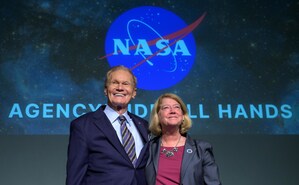WASHINGTON, Jan. 13, 2014 /PRNewswire-USNewswire/ -- An experiment designed by the Bronx High School of Science in New York is among the cargo which arrived to the International Space Station Sunday on the Orbital-1 cargo resupply mission.
(Logo: http://photos.prnewswire.com/prnh/20081007/38461LOGO)
Designed by tenth graders, the experiment, entitled "Effect of Microgravity in Structure of the Fungus Flammulina velutipes," is part of the NanoRacks-National Center for Earth and Space Science Education-Orion payload.
This experiment seeks to understand the effect of microgravity on the fungus Flammulina velutipes, classified as Basidiomycota or gill fungus (mushroom) because there already is ample evidence that gravity plays a profound role on the growth and structural development of F. velutipes.
Orbital-1 is NASA's first contracted resupply mission to the space station by U.S. company Orbital Sciences Corp. of Dulles, Va. Orbital's Cygnus spacecraft launched atop the company's Antares rocket from NASA's Wallops Flight Facility in eastern Virginia on Jan. 9. Expedition 38 crew members captured the Orbital-1 Cygnus using the space station's robotic arm at 6:08 a.m. Sunday, Jan. 12.
Orbital developed its Antares and Cygnus with NASA and successfully completed a test mission to the space station in September, enabling the first of eight planned contract resupply flights by the company. The capsule is scheduled to remain attached to the station through mid-January. It then will return for a destructive reentry in Earth's atmosphere.
The International Space Station is a convergence of science, technology and human innovation that demonstrates new technologies and makes research breakthroughs not possible on Earth. The space station has had continuous human occupation since November 2000. In that time it has been visited by more than 200 people and a variety of international and commercial spacecraft. The space station remains the springboard to NASA's next great leap in exploration, including future missions to an asteroid and Mars.
For more information about the Orbital-1 mission and the International Space Station, visit:
SOURCE NASA
WANT YOUR COMPANY'S NEWS FEATURED ON PRNEWSWIRE.COM?
Newsrooms &
Influencers
Digital Media
Outlets
Journalists
Opted In






Share this article